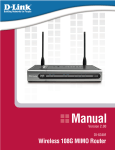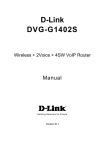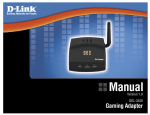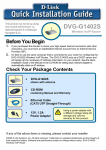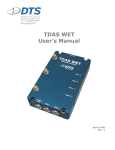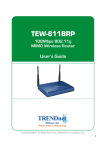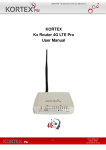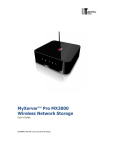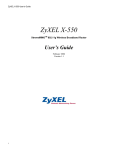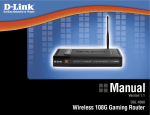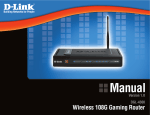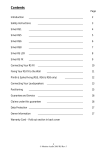Download D-Link DVG-G1402S - Wireless Broadband VoIP Router User`s manual
Transcript
DVG-G1402S User’s Manual Table of Contents Table of Contents Package Contents ..................................................................................................... 3 Introduction ................................................................................................................ 4 Features and Benefits ............................................................................................... 5 Hardware Overview ................................................................................................... 6 Wireless Basics ......................................................................................................... 8 Wireless Installation Considerations.......................................................................... 9 Getting Started ........................................................................................................ 10 Using the Configuration Utility ................................................................................. 13 Setup Wizard ...................................................................................................... 14 Wireless Settings ............................................................................................... 17 Wireless Security ............................................................................................... 18 WEP Encryption ................................................................................................. 20 WPA Authentication ............................................................................................ 21 WPA-PSK Authentication ................................................................................... 22 Wireless MAC Filtering....................................................................................... 23 WAN Settings ..................................................................................................... 24 LAN Settings ...................................................................................................... 27 DHCP Settings ................................................................................................... 28 Static DHCP Settings ......................................................................................... 29 DNS Proxy ......................................................................................................... 30 Virtual Server Settings ....................................................................................... 31 Filtering Configuration ........................................................................................ 32 Firewall Settings ................................................................................................. 34 RIP Settings ....................................................................................................... 36 Routing ............................................................................................................... 37 NAT Settings ...................................................................................................... 38 Admin Settings ................................................................................................... 43 System Settings ................................................................................................. 44 Firmware Upgrade ............................................................................................. 45 Time Server Settings.......................................................................................... 46 Reboot................................................................................................................ 47 Device Information ............................................................................................. 48 Stats ................................................................................................................... 49 Diagnostics......................................................................................................... 50 Troubleshooting ....................................................................................................... 51 Technical Specifications .......................................................................................... 56 Contacting Technical Support .................................................................................. 58 Warranty .................................................................................................................. 59 Registration ............................................................................................................. 61 D-Link Systems, Inc. 2 Package Contents DVG-G1402S User’s Manual Package Contents Your DVG-G1402S purchase includes the following: D-Link DVG-G1402S Wireless G VoIP Router Manual and Warranty on CD Ethernet Cable Standard RJ-11 Phone Cable Quick Installation Guide 12VDC 1.25A Power Adapter If any of the above items are missing, please contact your reseller. System Requirements for Configuration: A computer or laptop with an Ethernet adapter. A current web-browser (e.g., Internet Explorer 6.0 or Netscape Navigator 7.0 or later) for configuration. An active subscription to a VoIP Broadband Phone Service D-Link Systems, Inc. 3 DVG-G1402S User’s Manual Introduction Introduction D-Link® introduces the DVG-G1402S Broadband VoIP Wireless Router. The DVG-G1402S is designed for homes or small businesses ready to wirelessly share Internet access and enable Voice over IP. The DVG-G1402S maximizes your broadband investment by using the same connection for both voice and data. Once service has been established with a VoIP Service Provider, simply connect up to two regular phones to the DVG-G1402S and you are ready to make VoIP calls. Calling over the Internet is simple and works just like a regular telephone, complete with dial tone. The DVG-G1402S is also an 802.11g wireless router, allowing wireless clients to connect to and share your broadband Internet connection. A built-in 4-port switch makes it possible to connect up to four Ethernet-enabled computers or devices to also share your Internet connection. The Broadband VoIP Wireless Router also includes integrated firewall and voice features to keep your network running at optimal speeds. Packet filtering technology monitors your network connection from malicious attacks. Enhanced voice compression technology ensures that the quality of VoIP calls will be similar to calls made using standard phone service. The DVG-G1402S Broadband VoIP Wireless Router is a great all-in-one voice and data solution for any home or small business. Enjoy the benefits of both 802.11g wireless connectivity and VoIP broadband phone service. D-Link Systems, Inc. 4 Features and Benefits DVG-G1402S User’s Manual Features and Benefits Voice over IP Technology The DVG-G1402S allows users to use a regular telephone connected to the VoIP gateway to make voice calls over the Internet. This technology will reduce telephone charges compared to calls made on an analog telephone line. SIP Technology The Session Initiation Protocol (SIP) signaling protocol allows telephone calls to be made over the Internet. In addition to telephony service, SIP technology supports other multimedia applications such as video, instant messaging, and other realtime data for interactive communication sessions. Simple and Easy Installation Installing the D-Link DVG-G1402S is as simple as plugging a telephone cord into the phone jack. With all the accessories and cables that are included with the DVG-G1402S, a complete installation can be completed in minutes. Quality of Service (QoS) With its enhanced voice compression feature, the quality will be similar to voice calls made on standard analog telephone. Calls made through the DVG-G1402S will be clear and have echo cancellations to reduce voice delays which are seen on many other VoIP products. Users should not notice any difference from an analog telephone and the digital VoIP telephone. Built-in Switch The 10/100 Fast Ethernet port can also be connected to a D-Link DSS-5+ switch (or any standard Fast Ethernet switch) allowing users to quickly and easily share an Internet connection with multiple computers and devices. The Fast Ethernet port on the DVG-G1402S automatically senses and accepts the type of CAT5 cable you attach – whether straight-through or crossover. Remote Configuration For Network Administrators the DVG-G1402S’s settings can be easily configured using the convenient and secure Web-based Interface. This feature allows administrators to reconfigure the DVG-G1402S while away from the device. Wirelessly Share Your Internet Connection Share your broadband Internet connection wirelessly using the DVG-G1402S VoIP router. The DVG-G1402S provides up to 54Mbps* wireless connection with other 802.11g wireless clients. * Maximum wireless signal rate based on IEEE Standard 802.11g specifications. Actual data throughput will vary. Network conditions and environmental factors, including volume of network traffic, building materials and construction, and network overhead lower actual data throughput rate. D-Link Systems, Inc. 5 Hardware Overview DVG-G1402S User’s Manual Front Panel Phone LEDs This LED displays the VoIP status and Hook/Ringing activity on the phone port that is used to connect your normal telephone(s). MWI: Lights to indicate a voicemail is waiting. Hook/Ring: If a phone connected to a phone port is off the hook or in use, this LED will light solid. When a phone is ringing, the indicator will blink. Status LED The Status LED will turn on when the router is connected to a VoIP service provider. The LED will turn off if not connected to a service provider. WLAN LED A steady light indicates a wireless connection. A blinking light indicates that the DVG-G1402S is receiving/transmitting from/to the wireless network. Power LED A steady light indicates a proper connection to a power source. Alarm LED The Alarm LED will light solid red if the self-test or bootup fails. The LED will flash red slowly when the device is booting. Prov LED A blinking light indicates the router is attempting to connect with the VoIP service provider. Once the service connects, the LED will turn off. LAN LEDs When a connection is established the 10 or 100 LED (bottom) will light up solid on the appropriate port. The LEDs will blink to indictate activity. If the 10 or 100 LED does not light up when a cable is connected, verify the cable connections and make sure your devices are powered on. WAN LEDs When a connection is established the 10 or 100 LED will light up solid. The LED will blink to indictate activity. If the 10 or 100 LED does not light up when a cable is connected, verify the cable connections and make sure your devices are powered on. D-Link Systems, Inc. 6 Hardware Overview DVG-G1402S User’s Manual Rear Panel Antenna Connect to a wireless network. Reset Button This button will restore the factory default settings of the DVG-G1402S. LAN Ports (1-4) Connect to your Ethernet enabled computers using Ethernet cabling. WAN Port Phone Port (1-2) Connects to your broadband modem using an Ether net cable. Connect to your phones using standard phone cabling (RJ-11). Power Receptor Receptor for the provided power adapter. D-Link Systems, Inc. 7 DVG-G1402S User’s Manual Wireless Basics Wireless Basics D-Link wireless products are based on industry standards to provide easy-to-use and compatible high-speed wireless connectivity within your home, business or public access wireless networks. D-Link wireless products will allow you access to the data you want, when and where you want it. You will be able to enjoy the freedom that wireless networking brings. A Wireless Local Area Network (WLAN) is a computer network that transmits and receives data with radio signals instead of wires. WLANs are used increasingly in both home and office environments, and public areas such as airports, coffee shops and universities. Innovative ways to utilize WLAN technology are helping people to work and communicate more efficiently. Increased mobility and the absence of cabling and other fixed infrastructure have proven to be beneficial for many users. Wireless users can use the same applications they use on a wired network. Wireless adapter cards used on laptop and desktop systems support the same protocols as Ethernet adapter cards. People use WLAN technology for many different purposes: Mobility - Productivity increases when people have access to data in any location within the operating range of the WLAN. Management decisions based on real-time information can significantly improve worker efficiency. Low Implementation Costs - WLANs are easy to set up, manage, change and relocate. Networks that frequently change can benefit from WLANs ease of implementation. WLANs can operate in locations where installation of wiring may be impractical. Installation and Network Expansion - Installing a WLAN system can be fast and easy and can eliminate the need to pull cable through walls and ceilings. Wireless technology allows the network to go where wires cannot go - even outside the home or office. Inexpensive Solution - Wireless network devices are as competitively priced as conventional Ethernet network devices. The DVG-G1402S saves money by providing multi-functionality, configurable in one of four different modes. Scalability - WLANs can be configured in a variety of ways to meet the needs of specific applications and installations. Configurations are easily changed and range from Peer-to-Peer networks suitable for a small number of users to larger Infrastructure networks to accommodate hundreds or thousands of users, depending on the number of wireless devices deployed. Standards-based Technology The DVG-G1402S Wireless Gaming Adapter utilizes the 802.11b and the 802.11g standards. The IEEE 802.11g standard is an extension of the 802.11b standard. It increases the data rate up to 54Mbps (108Mbps in Super G mode) within the 2.4GHz band, utilizing OFDM technology. This means that in most environments, within the specified range of this device, you will be able to transfer large files quickly or even watch a movie in MPEG format over your network without noticeable delays. This technology works by transmitting high-speed digital data over a radio wave utilizing OFDM (Orthogonal Frequency Division Multiplexing) technology. OFDM works by splitting the radio signal into multiple smaller sub-signals that are then transmitted simultaneously at different frequencies to the receiver. OFDM reduces the amount of crosstalk (interference) in signal transmissions. The D-Link DVG-G1402S will automatically sense the best possible connection speed to ensure the greatest speed and range possible. D-Link Systems, Inc. 8 DVG-G1402S User’s Manual Wireless Installation Considerations Wireless Installation Considerations The D-Link DVG-G1402S lets you access your network, using a wireless connection, from virtually anywhere within its operating range. Keep in mind, however, that the number, thickness and location of walls, ceilings, or other objects that the wireless signals must pass through, may limit the range. Typical ranges vary depending on the types of materials and background RF (radio frequency) noise in your home or business. The key to maximizing wireless range is to follow these basic guidelines: 1 Keep the number of walls and ceilings between the DVG-G1402S and other network devices to a minimum - each wall or ceiling can reduce your router’s range from 3-90 feet (1-30 meters.) Position your devices so that the number of walls or ceilings is minimized. 2 Be aware of the direct line between network devices. A wall that is 1.5 feet thick (.5 meters), at a 45-degree angle appears to be almost 3 feet (1 meter) thick. At a 2-degree angle it looks over 42 feet (14 meters) thick! Position devices so that the signal will travel straight through a wall or ceiling (instead of at an angle) for better reception. 3 Building Materials make a difference. A solid metal door or aluminum studs may have a negative effect on range. Try to position access points, wireless routers, and computers so that the signal passes through drywall or open doorways. Materials and objects such as glass, steel, metal, walls with insulation, water (fish tanks), mirrors, file cabinets, brick, and concrete will degrade your wireless signal. 4 Keep your product away (at least 3-6 feet or 1-2 meters) from electrical devices or appliances that generate RF noise. 5 If you are using 2.4GHz cordless phones or X-10 (wireless products such as ceiling fans, lights, and home security systems), your wireless connection may degrade dramatically or drop completely. Make sure your 2.4GHz phone base is as far away from your wireless devices as possible. The base transmits a signal even if the phone in not in use. D-Link Systems, Inc. 9 DVG-G1402S User’s Manual Getting Started Getting Started If your computer connects directly to a DSL or Cable modem and does not connect to a router, follow the steps below to install your DVG-G1402S. After the steps are completed, your setup should look similar to the diagram below. D-Link Systems, Inc. 10 DVG-G1402S User’s Manual Getting Started Connecting the DVG-G1402S Directly to a Modem and Computer 1 Turn off your computer. 2 Disconnect the power to your Cable/DSL Modem (unplug or turn off the power switch). 3 Unplug the existing Ethernet cable that is connected to your Cable/DSL Modem’s LAN or Ethernet port. Leave the other end of this cable attached to your PC. 4 Plug the Ethernet cable connector that you just removed from the modem into one of the four LAN ports on the back of the DVG-G1402S. The other end remains attached to the PC. 5 Attach one end of the Ethernet Cable (blue) provided in this package to the LAN or Ethernet Port on the Cable/DSL Modem. 6 Attach the other end of the provided Ethernet Cable to the WAN Port of the DVG-G1402S. 7 Attach one end of the provided phone cable (black) to a standard analog telephone. 8 Attach the other end of the phone cable to the phone port labeled 1 on the rear panel of the DVG-G1402S. 9 Reconnect the power to the Cable/DSL Modem (plug in or turn on the power switch). 10 Connect the Power Adapter to the Power Connecter on the DVG-G1402S. 11 Connect the other end of the Power Adapter to an available electrical outlet (Wall Socket or Surge Protector). 12 Restart your PC. Next you must configure your DVG-G1402S. If you are using a DSL Modem with a PPPoE or DHCP connection, you will need to continue on to the following section. If you are using a Cable Modem, and your service provider requires a MAC address, skip this section and refer to the section titled “MAC Cloning for Cable Connection.” Also be sure to change your computer’s IP settings to DHCP (to automatically be assigned an IP address from the DVG-G1402S) regardless of what type of Internet connection you have (Please refer to your NIC card’s manual for detailed information). If your cable service provider does not require a MAC address, setup of the DVG-G1402S with a modem and computer is complete. D-Link Systems, Inc. 11 DVG-G1402S User’s Manual Getting Started Connecting the DVG-G1402S Behind an Existing Router If you wish to connect your DVG-G1402S behind a router, follow the steps below. 1. Turn off your Computer. 2. Disconnect the power to the Cable/DSL Modem (unplug or turn off the power switch). 3. Disconnect the power to your existing router (unplug or turn off the power switch). 4. Unplug the existing CAT5 Ethernet cable from the “LAN” port of your existing Router. 5. Leave the other end of this cable attached to your PC. 6. Plug the CAT5 Ethernet Cable from the PC into the “LAN” port of the DVG-G1402S. 7. Unpack the CAT5 Ethernet Cable (blue) that came with the DVG-G1402S. 8. Attach one end of this CAT5 Ethernet Cable (blue) to the “WAN” Port on the rear of the DVG-G1402S. 9. Attach the other end of this CAT5 Ethernet Cable (blue) to the “LAN” port of your existing router. 10. Be sure that the CAT5 Ethernet Cable that is plugged into the “WAN” Port of your existing router is still plugged into your Cable/DSL Modem. 11. Attach one end of the phone cable to a standard analog telephone. 12. Attach the other end of this cable to phone port “1” on the rear of the DVG-G1402S. 13. Connect the Power Adapter to the Power Connecter on the DVG-G1402S. 14. Connect the other end of the Power Adapter to an available electrical outlet (Wall Socket or Surge Protector). 15. Reconnect the power to the Cable/DSL Modem (plug in or turn on). 16. Reconnect the power to your existing Router (plug in or turn on the power switch). 17. Restart your PC. By default the unit is already configured to work behind a router. Be sure to change your computer’s IP settings to DHCP (to automatically be assigned an IP address from the DVG-G1402S) regardless of what type of internet connection you have. (Please refer to your NIC card’s manual for detailed information.) Installation behind a router is now complete. D-Link Systems, Inc. 12 DVG-G1402S User’s Manual Using the Configuration Utility Using the Configuration Utility Prior to using your Web browser for web-based management, if DHCP is not enabled on your computer, be sure to assign a static IP address to the VoIP Router. Use the computer that was last connected directly to your cable/DSL modem. Go to Start > right-click My Network Places > select Properties > Right-click Local Area Connection > select Properties > double-click Internet Protocol (TCP/IP). Set your PC’s IP address to 192.168.15.15 and the subnet mask to 255.255.255.0. The default gateway and primary DNS server IP addresses should be the LAN IP address of the DVG-G1402S router (192.168.15.1). Click OK. In order to use a web browser to configure the VoIP Router you must make sure it has a valid Ethernet connection to a PC or LAN via its LAN port. Access the configuration utility to check the LAN port by entering the IP Address into your web browser address field. Type 192.168.15.1 (the IP Address) into the address field of your browser. D-Link Systems, Inc. 13 DVG-G1402S User’s Manual Using the Configuration Utility Using the Configuration Utility (continued) Click Run Wizard. Click Next. Enter a NTP server or leave blank to use the default server. Select your time zone from the drop-down menu. Click Next. D-Link Systems, Inc. 14 DVG-G1402S User’s Manual Using the Configuration Utility Using the Configuration Utility (continued) Select a channel. For best results, use 1, 6, or 11. Enter the SSID, or Service Set Identifier, which is the workgroup name of your Wireless Network. All devices must all have the same SSID to communicate on the wireless network. The SSID can be up to 32 characters and is case-sensitive. Click Next. Select the Authentication Type: None, WEP, or WPA-PSK. Click Next. If you selected WEP, enter the Encryption Type (Hex or ASCII), the encryption level (64, 128, or 152-bit), and the WEP key. Click Next. If you selected WPA-PSK, enter the Passphrase. The passphrase must be between 8 and 63 characters. Click Next. D-Link Systems, Inc. 15 DVG-G1402S User’s Manual Using the Configuration Utility Using the Configuration Utility (continued) If you selected Dynamic, enter a host name (optional) and click Clone MAC Address. Click Next. If you selected Static, enter the IP address, subnet mask, default gateway, and DNS server(s) supplied by your ISP. Click Next. If you selected PPPoE, enter your username and password supplied by your ISP. Note: You will no longer use the PPPoE software that is installed on your computer. Make sure you disable or uninstall the software. Click Next. Setup is finished. Click Restart to reboot the DVG-G1402 router. Once the router is finished rebooting, turn on your modem and allow up to 2 minutes to connect to your ISP. Click Restart. D-Link Systems, Inc. 16 Using the Configuration Utility DVG-G1402S User’s Manual Using the Configuration Utility (continued) Home > Wireless > LAN Basic Wireless LAN Usage: Select Enabled or Disabled. Disabled will turn off the wireless function of the router. Wireless LAN Mode: Select the wireless mode of your network: 802.11G - Select if you are using all 802.11G devices. 802.11B - Select if you are using all 802.11B devices. 802.11B/G - Select if you have a mixed network of 802.11B and G devices. Channel: Preamble Config: IEEE Protection: Set to Long, Short, or Long and Short (both). Select Enabled or Disabled. SSID: SSID, or Service Set Identifier, is the workgroup name of your Wireless Network. All devices must all have the same SSID to communicate on the Wireless Network. The SSID can be up to 32 characters and is case-sensitive. Hidden SSID: Select Enabled to disable the SSID broadcast. This is to prevent users from seeing your wireless network. Apply: D-Link Systems, Inc. Select the wireless channel (1-11). For best results, use channel 1,6, or 11. Click Apply to save your settings. 17 Using the Configuration Utility DVG-G1402S User’s Manual Using the Configuration Utility (continued) Wireless Security The DVG-G1402S offers 3 types of wireless security - WEP, WPA-PSK, and WPA. WEP (Wired Equivalent Privacy) is a method of encrypting data for wireless communication intended to provide the same level of privacy as a wired network. To gain access to a WEP network, you must know the key. The key is a string of characters that you create. When using WEP, you must determine the level of encryption. The type of encryption determines the key length. 128-bit encryption requires a longer key than 64-bit encryption. Keys are defined by entering in a string in HEX (hexadecimal - using characters 0-9, A-F) or ASCII (American Standard Code for Information Interchange – alphanumeric characters) format. ASCII format is provided so you can enter a string that is easier to remember. The ASCII string is converted to HEX for use over the network. Four keys can be defined so that you can change keys easily. Example: 64-bit hexadecimal keys are exactly 10 characters in length. (12345678FA is a valid string of 10 characters for 64-bit encryption) 128-bit hexadecimal keys are exactly 26 characters in length. (456FBCDF123400122225271730 is a valid string of 26 characters for 128-bit encryption) 64-bit ASCII keys are exactly 5 characters in length (DMODE is a valid string of 5 characters for 64-bit encryption) 128-bit ASCII keys are exactly 13 characters in length (2002HALOSWIN1 is a valid string of 13 characters for 128-bit encryption) WPA-PSK (Wi-Fi Protected Access - Pre-Shared Key) is a Wi-Fi standard that was designed to improve upon the security features of WEP (Wired Equivalent Privacy). WPA has improved data encryption through the Temporal Key Integrity Protocol (TKIP). TKIP scrambles the keys using a hashing algorithm and, by adding an integrity checking feature, ensures that the keys haven’t been tampered with. The key or passphrase is an alpha-numeric password between 8 and 63 characters long. The passphrase can include symbols (!?*&_) and spaces. Make sure you enter this key exactly the same as on your access point or wireless router. You may also enter a hexadecimal key (using characters 0-9, A-F). WPA encorporates user authentication, which is generally missing in WEP, through the extensible authentication protocol (EAP). EAP is built on a more secure public key encryption system to ensure that only authorized network users can access the network. D-Link Systems, Inc. 18 Using the Configuration Utility DVG-G1402S User’s Manual Using the Configuration Utility (continued) Home > Wireless > LAN Authorization Authorization Type: Select the encryption/authentication type: No Auth - Select if no encryption/authentication is being used on your wireless network. WEP - Select to use WEP encryption. WPA - Select to use WPA (RADIUS server) to authenticate your wireless clients. WPA-PSK - Select to use WPA-PSK. Please refer to the previous page for more information on wireless security. D-Link Systems, Inc. 19 Using the Configuration Utility DVG-G1402S User’s Manual Using the Configuration Utility (continued) Home > Wireless > LAN Authorization (WEP) Auth Method: Encryption Type: Key (1-4): Select the type of authentication: Open Auth - Any wireless client can associate with the wireless router but cannot exchange data unless the client has the same WEP key. Shared Auth (recommended) - Wireless clients must have the same WEP key to associate and exchange data. Auto - Automatically detects the authentication used. Select HEX or ASCII: HEX - Only numbers (0-9) and letters (A-F) are valid. ASCII - May use all numbers/letters for your WEP key. Select the encryption level (64,128, or 152-bit) and enter your WEP key. You may enter up to 4 different keys. Note: Your network may slow down and wireless signal may degrade when enabling WEP due to the added overhead. Apply: D-Link Systems, Inc. Click Apply to save your settings. 20 Using the Configuration Utility DVG-G1402S User’s Manual Using the Configuration Utility (continued) Home > Wireless > LAN Authorization (WPA) Radius Server: Port: Secret: Group Key Interval: Apply: D-Link Systems, Inc. Enter the IP address of your RADIUS server. Enter the port used (default is 1812). Enter the security key. Enter the group key interval value (default is 1800). Click Apply to save your settings. 21 Using the Configuration Utility DVG-G1402S User’s Manual Using the Configuration Utility (continued) Home > Wireless > LAN Authorization (WPA-PSK) Passphrase: Group Key Interval: Apply: D-Link Systems, Inc. Enter a key (passphrase). The key is an alpha-numeric password between 8 and 63 characters long. The password can include symbols (!?*&_) and spaces. Make sure you enter this key exactly the same on all other wireless clients. Enter the group key interval value (default is 1800). Click Apply to save your settings. 22 Using the Configuration Utility DVG-G1402S User’s Manual Using the Configuration Utility (continued) Home > Wireless > MAC Address Filter MAC Address: D-Link Systems, Inc. Enter the MAC address of the wireless client you would like to allow wireless connectivity to the router. State: Select Enabled or Disabled. Apply: Click Apply to save your settings. 23 Using the Configuration Utility DVG-G1402S User’s Manual Using the Configuration Utility (continued) Home > WAN > Dynamic IP Host Name: Enter a host name. Most ISPs do not require this. MAC Address: Manually enter the MAC address of the computer that was last connected directly to the Internet. Most cable ISPs will authenticate by the MAC address of the device that is connected to the modem (router or computer). Few ISPs require you to register the MAC address with them. In most cases, turning off the power to the modem for 3-5 minutes will allow you to use a new device to connect. Clone MAC Address: If you are using the computer that was last connected directly to the modem, click the Clone MAC Address button. Primary/Secondary DNS Address: You may enter the DNS if supplied by your ISP. Leave blank if you do not know or were supplied with DNS server IP addresses. Apply: Click Apply to save your settings. After the router reboots, you may need to unplug the power to your modem for about 1 minute and plug back in. Allow up to 3 minutes to connect to the Internet. In most cases, you should be able to connect right away. D-Link Systems, Inc. 24 Using the Configuration Utility DVG-G1402S User’s Manual Using the Configuration Utility (continued) Home > WAN > Static IP IP Address: Subnet Mask: Default Gateway: Primary/Secondary DNS Address: Apply: D-Link Systems, Inc. Enter the IP address supplied by your ISP. Enter the subnet mask. Enter the default gateway. Enter the DNS server IP address(es). Click Apply to save your settings. 25 Using the Configuration Utility DVG-G1402S User’s Manual Using the Configuration Utility (continued) Home > WAN > PPPoE User Name: Enter your PPPoE user name. Password: Enter your PPPoE password. Retype Password: Primary/Secondary DNS Address: PPPoE Status: Connect/Disconnect: Apply: Enter your PPPoE password again. You may enter the DNS if supplied by your ISP. Leave blank if you do not know or were supplied with DNS server IP addresses. The status of your connect will be displayed here. Click Connect to manually connect to your DSL service. You may manually disconnect from your service by clicking Disconnect. Click Apply to save your settings. Note: You must disable or uninstall the PPPoE software (Enternet 300, WinPoet, etc) from your computer. You do not need the software since the router is authenticating to your DSL provider. The software to connect to your service will not work through the router. Simply connect to the Internet by opening your web browser. D-Link Systems, Inc. 26 Using the Configuration Utility DVG-G1402S User’s Manual Using the Configuration Utility (continued) Home > LAN IP Address: Subnet Mask: Apply: D-Link Systems, Inc. Enter the IP address you want to assign to the DVG-G1402S router. Enter the subnet mask. Click Apply to save your settings. 27 Using the Configuration Utility DVG-G1402S User’s Manual Using the Configuration Utility (continued) Home > DHCP Name: Enter a name for your DVG-G1402S unit (optional). State: Select Enabled or Disabled. If you disable DHCP, you must manually enter the IP settings on all your other network devices. Start IP Address: Enter the starting IP address of the IP address range you want to assign to your network devices. Gateway: Enter the default gateway you want to assign to your devices. This is usually the (LAN) IP address of the DVG-G1402S. IP Range: Enter the number of networking devices that will receive IP addresses from the DVG-G1402S. Leased Time: Apply: D-Link Systems, Inc. Enter the lease time. Enter 0 for no time limit. Click Apply to save your settings. 28 Using the Configuration Utility DVG-G1402S User’s Manual Using the Configuration Utility (continued) Home > DHCP > Static DHCP Name: IP address: Subnet Mask: Enter a name for your DVG-G1402S unit (optional). Enter the IP address you would like to assign. This address must be in the DHCP IP range. Enter the subnet mask. Default Gateway: Enter the default gateway you want to assign to your devices. This is usually the (LAN) IP address of the DVG-G1402S. MAC Address: Manually enter the MAC address of the computer or device you want to assign. DHCP Client: Select a device that has already been assigned an address from the drop-down list. Select it and then click the Clone button. Apply: Click Apply to save your settings. NOTE: When creating a Static DHCP entry, the IP address that you choose to have assigned needs to be in the range of the DHCP range. Entries created with IP addresses outside of this range will not take effect. D-Link Systems, Inc. 29 Using the Configuration Utility DVG-G1402S User’s Manual Using the Configuration Utility (continued) Home > Proxy DNS State: Proxy DNS IP Address: Apply: D-Link Systems, Inc. Select Enabled or Disabled. Enter the IP address of the Proxy server. Click Apply to save your settings. 30 Using the Configuration Utility DVG-G1402S User’s Manual Using the Configuration Utility (continued) Advanced > Virtual Server Private IP: Protocol Type: Select the protocol type: TCP, UDP, or Both. Start Global Port: Enter the starting port you want to open. The global port is the incoming (from the Internet) port. End Global Port: Enter the ending port you want to open. If you want to open only one port, enter the same port as the Starting Global Port. Start Local Port: Enter the starting port you want to open. The local port is the port used on your computer. In most cases, the global and local ports will be the same. End Local Port: Enter the ending port you want to open. If you want to open only one port, enter the same port as the Starting Local Port. Apply: D-Link Systems, Inc. Enter the IP address of the computer you want to open port(s) to. Click Apply to save your settings. 31 Using the Configuration Utility DVG-G1402S User’s Manual Using the Configuration Utility (continued) Advanced > FIlter > IP Filter Pass or Block: Select Block or Pass. Protocol: Select the protocol type: TCP, UDP, or Both. IP Address - Source: Enter the IP address of the source computer. IP Address - Destination: Subnet Mask - Source: Subnet Mask - Destination: Enter the IP address of the destination computer. Enter the subnet mask of the source computer. Enter the subnet mask of the destination computer. Source Start/End Port: Enter the port range you want to open. If you want to open only one port, enter the same port in both boxes. Destination Start/End Port: Enter the port range you want to open. In most cases, the source and destination port(s) will be the same. TCP Flag: Check the box to enable each of the optional TCP packet options. Firewall Rule State: Apply: D-Link Systems, Inc. Select to enable or disable the rule. Click Apply to save your settings. 32 Using the Configuration Utility DVG-G1402S User’s Manual Using the Configuration Utility (continued) Advanced > FIlter > MAC Filter MAC Address: State: Select to enable or disable the rule. Apply: Click Apply to save your settings. MAC Table: D-Link Systems, Inc. Enter the MAC address of the wired computer or device to allow connectivity to the DVG-G1402S. The MAC table will list the current “rules”. Click the edit button to make any changes or click the trash can icon to delete the rule. 33 Using the Configuration Utility DVG-G1402S User’s Manual Using the Configuration Utility (continued) Advanced > Firewall Pass or Block: Protocol: IP Address Source: IP Address Destination: Subnet Mask Source: Subnet Mask Destination: Enter the MAC address of the computer or device to allow connectivity to the DVG-G1402S. Select to enable or disable the rule. Enter the IP address of the source computer. Enter the IP address of the destination computer. Enter the subnet mask of the source computer. Enter the subnet mask of the destination computer. Source Start/End Port: Enter the port range you want to open. If you want to open only one port, enter the same port in both boxes. Destination Start/End Port: Enter the port range you want to open. In most cases, the source and destination port(s) will be the same. < : specifies the port numbers less than and equal to the Start Port number > : specifies the port numbers greater than and equal to the Start Port number = : sets the port number equal to the Start Port if there is no End Port specified; if an End Port number is specified, this defines a range of ports to filter. The range is defined as the port numbers between the Start Port and End Port, including the Start and End Port numbers. D-Link Systems, Inc. 34 Using the Configuration Utility DVG-G1402S User’s Manual Using the Configuration Utility (continued) Advanced > Firewall (continued) TCP Flag: Firewall Rule State: Apply: D-Link Systems, Inc. Check the box to enable each of the optional TCP packet options. Select to enable or disable the rule. Click Apply to save your settings. 35 Using the Configuration Utility DVG-G1402S User’s Manual Using the Configuration Utility (continued) Advanced > RIP RIP - Routing Information Protocol specifies how routers exchange information. With RIP, routers periodically exchange entire tables. LAN Version: LAN State: WAN Version: WAN State: Apply: D-Link Systems, Inc. Select RIPv1 or RIPv2. Select On or Off. Select RIPv1 or RIPv2. Select On or Off. Click Apply to save your settings. 36 Using the Configuration Utility DVG-G1402S User’s Manual Using the Configuration Utility (continued) Advanced > Routing Use Static Routing to specify a route used for data traffic within your WAN or LAN. This can be used to specify that all packets destined for a particular subnet use a predetermined gateway. IP Address: Subnet Mask: Enter the subnet mask. Gateway: Enter the IP Address of the gateway used for traffic destined for the specified subnet or device. Interface: Select WAN or LAN. Metric: D-Link Systems, Inc. Enter the IP address of the subnet or device where packets are routed to. Type in the maximum number of hops allowed for the static route. State: Enable or disable the route. Apply: Click Apply to save your settings. 37 Using the Configuration Utility DVG-G1402S User’s Manual Using the Configuration Utility (continued) Advanced > NAT > NAT Configuration NAT Interface IP Address: NAT Interface Netmask: NAT Function: Apply: D-Link Systems, Inc. Displays the IP address of the LAN port on the DVG-G1402S. Displays the subnet mask of the LAN port on the DVG-G1402S. Select Enabled or Disabled. Click Apply to save your settings. 38 Using the Configuration Utility DVG-G1402S User’s Manual Using the Configuration Utility (continued) Advanced > NAT > Dynamic NAT Global IP Start: Enter the start of the global IP range. Global IP End: Enter the end of the global IP range. Local IP Start: Enter the start of the local IP range. Local IP End: Enter the end of the local IP range. Apply: Dynamic NAT Table: D-Link Systems, Inc. Click Apply to save your settings. Displays the current NAT entries. Click the edit icon to make changes or the trash can icon to delete the entry. 39 Using the Configuration Utility DVG-G1402S User’s Manual Using the Configuration Utility (continued) Advanced > NAT > Static NAT Local IP Address: Enter the local IP address you wish to redirect globally. Global IP Address: Enter the global IP address you wish to redirect locally. Apply: Static NAT Table: D-Link Systems, Inc. Click Apply to save your settings. Displays the current static NAT entries. Click the edit icon to make changes or the trash can icon to delete the entry. 40 Using the Configuration Utility DVG-G1402S User’s Manual Using the Configuration Utility (continued) Advanced > NAT > Misc Bridge Mode: Select On or Off. DMZ Forwarding Mode: Select Enabled or Disabled. The DMZ feature allows you to forward all incoming ports to one computer on the local network. The DMZ, or Demilitarized Zone, will allow the specified computer to be exposed to the Internet. DMZ is useful when a certain application or game does not work through the firewall. The computer that is configured for DMZ will be completely vulnerable on the Internet, so it is suggested that you try opening ports from the Virtual Server or Firewall settings before using DMZ. DMZ Host IP Address: Enter the IP address of the computer/device you want to forward all ports to. Signaling TOS: This is used to set type of service value in IP header for VoIP signaling RTP ToS: This is used to set type of service value in IP header for RTP packets Receive Gain: This is used to set the Receive gain of the device. Transmission Gain: This is used to set the Transmit gain of the device. Digit Timeout: D-Link Systems, Inc. This is user-defined digital interval timer for distinguish user end of dialing. 41 Using the Configuration Utility DVG-G1402S User’s Manual Using the Configuration Utility (continued) Advanced > NAT > Misc (continued) Call Waiting Alert Tone: T.38: This is used to enable or disable the t.38 protocol. T.38 is a standard for sending FAX across IP networks. MTU Size: Enter the MTU (Maximum Transmission Unit). The default setting (for most cable providers) is 1500. Most DSL providers use 1492. UPnP: IPSec Passthrough/PPTP Passthrough: PPPoE Passthrough: WAN Port Speed Selection: Apply: D-Link Systems, Inc. This is used to enable or disable the call waiting alert tone. Select to enable or disable UPnP™ (Universal Plug and Play). The device supports VPN (Virtual Private Network) pass-through for both PPTP (Point-to-Point Tunneling Protocol) and IPSec (IP Security). Once IPSec or PPTP pass-through is enabled, there is no need to open up virtual services. Multiple VPN connections can be made through the device. This is useful when you have many VPN clients on the local area network. Select to enable or disable PPPoE passthrough. Which allow user to select their WAN port speed of the device: 100Mbps Full/Half, 10Mbps Full/Half or Auto. Click Apply to save your settings. 42 Using the Configuration Utility DVG-G1402S User’s Manual Using the Configuration Utility (continued) Tools > Admin Web Port Number: Enter the port number to use when accessing the web-based configuration utility from the WAN port. Access Web from WAN: Select to enable or disable the ability to access the web-based configuration utility from the Internet (WAN). Apply: D-Link Systems, Inc. Click Apply to save your settings. 43 Using the Configuration Utility DVG-G1402S User’s Manual Using the Configuration Utility (continued) Tools > System The current system settings can be saved as a file onto the local hard drive. The saved file or any other saved setting file created by the DVG-G1402S can be uploaded into the unit. To restore a system settings file, click on Browse to search the local hard drive for the file to be used. Backup: Click the Backup button to save your current settings to a file. Browse: Click the Browse button to locate a saved configuration file. Upload: Once you locate the file, click Upload to overwrite the current settings with the settings saved to the file. Reset to Factory Default: D-Link Systems, Inc. Click this button to reset the DVG-G1402S back to the factory default settings. 44 Using the Configuration Utility DVG-G1402S User’s Manual Using the Configuration Utility (continued) Tools > Firmware TFTP Server Address: Last TFTP Server Address: Firmware Update: File Name: Last Update Status: Apply: D-Link Systems, Inc. Enter the IP address of the computer running the TFTP software. The last IP address used will be displayed. Select Enabled or Disabled. Enter the name of the firmware file. The last update status will be displayed. Click Apply to save your settings. 45 Using the Configuration Utility DVG-G1402S User’s Manual Using the Configuration Utility (continued) Tools > Time NTP Server: Time Zone: Apply: D-Link Systems, Inc. Enter a time server either by IP address or DNS name. Select your time zone from the drop-down menu. Click Apply to save your settings. 46 Using the Configuration Utility DVG-G1402S User’s Manual Using the Configuration Utility (continued) Tools > Reboot Reboot: D-Link Systems, Inc. Click to reboot your DVG-G1402S. 47 Using the Configuration Utility DVG-G1402S User’s Manual Using the Configuration Utility (continued) Status > Device Info The Device Information screen will display the MAC address, firmware version, and the IP settings for both the WAN port and LAN port. D-Link Systems, Inc. 48 Using the Configuration Utility DVG-G1402S User’s Manual Using the Configuration Utility (continued) Status > Stats Traffic Statistics will display transmitted and received packets passing through the DVG-G1402S. Click the Refresh button to update the statistics. Clicking the Reset button will set all values to zero. D-Link Systems, Inc. 49 Using the Configuration Utility DVG-G1402S User’s Manual Using the Configuration Utility (continued) Status > Diagnostics This page will allow you to test connectivity to computers and devices on your LAN by pinging. Enter the IP address you want to ping and click the Test button. D-Link Systems, Inc. 50 DVG-G1402S User’s Manual Troubleshooting Troubleshooting 1. Why can’t I connect the DVG-G1402S to my network? Check that the LED indicators for the broadband modem are indicating normal activity. If not, there may be a problem with the broadband connection. Check that the LED indicators on the wireless router are functioning properly. If not, check that the AC power and Ethernet cables are firmly connected. Check that the IP address, subnet mask, gateway, and DNS settings are correctly entered for the network. Check that the Network Connection for the wireless client is configured properly. Your wireless clients should be in Infrastructure mode. If security is enabled, make sure that the correct encryption key or passphrase is entered on both the DVG-G1402S and the wireless clients. 2. What variables may cause my wireless products to lose reception? D-Link products let you access your network from virtually anywhere you want. However, the positioning of the products within your environment will affect the wireless range. Please refer to Installation Considerations in the Wireless Basics section of this manual for further information about the most advantageous placement of your D-Link wireless products. 3. Why does my wireless connection drop? Antenna orientation – try different antenna orientations for the DVG-G1402S. Try to keep the antenna at least 6 inches away from the wall or other objects. Do not place this router in a closet or cabinet. If you are using 2.4GHz cordless phones, X-10 equipment or other home security systems, ceiling fans, and lights, your wireless connection will degrade dramatically or drop altogether. Try changing the channel on your router, access point and all other devices on the network to avoid interference. Keep your product away (at least 3-6 feet) from electrical devices that generate RF noise, like microwaves, monitors, electric motors, UPS units, etc. D-Link Systems, Inc. 51 DVG-G1402S User’s Manual FAQs Frequently Asked Questions Q: I have completed the installation of my D-Link DVG-G1402S, but do not hear a dial tone. A: Be sure that the unit is properly plugged into the AC outlet, the analog phone is properly plugged into the RJ-11 jack behind the unit, and the power connector is plugged in. Verify that status lights are lit/blinking. 1) Verify the Power light is on. 2) Initially the Alarm light will blink. 3) The provision (prov.) Light will also blink during the boot up. 4) When Provisioning is complete, the Status light will blink continuously. 5) Verify that the WAN light is lit along with the corresponding LAN port light and that the PC is plugged into on the back of the DVG-G1402S. At this point, the “Power” light, “Status” light, “WAN” light, and “LAN” light (if the PC or another device is plugged in to the LAN port) should be lit green. Confirm that your service has been activated by your VoIP service provider. Q: After setting up the DVG-G1402S, I cannot surf the internet. A: Re-check all the cabling installations. Make sure that the Ethernet cable from the PC is plugged into one of the LAN ports of the DVG-G1402S and the Ethernet cable from the cable modem is plugged into the WAN port of the DVG-G1402S. Once this is verified but you still cannot access the Internet, then verify the configurations via the Web GUI. 1) Access the Web GUI by entering the IP address: 192.168.15.1 in the Address bar. 2) Select Configure WAN/LAN Access. 3) Select Configure WAN Port. 4) In the WAN Restart settings – Get IP from one of the following: a. 5) 6) 7) 8) 9) 10) If using a cable modem - Choose DHCP and fill in the available information and click “Save”. User will be prompted to either “Save changes and reboot system now” or “Continue and ‘Restart System’ later”. Choose “Save changes and reboot system now” and wait for the unit to reboot (not the PC). b. If using a DSL modem – Choose PPPoE and fill in the available information and click “Save”. User will be prompted to either “Save changes and reboot system now” or “Continue and ‘Restart System’ later”. Choose “Save changes and reboot system now” and wait for the unit to reboot (not the PC). c. If the service provider gives a specific IP address – Choose Manual and enter the given information in the fields. Once the DVG-1420SL has rebooted, select Configure LAN Port. Select Dynamic IP assignment. In the “State” field, make sure that “Enabled” is selected. Select “Save” and choose to reboot the DVG-G1402S (not the PC). Verify that the IP address on the PC has an address of 192.168.15.x , where “x” is a number assigned by the DVG-1420SL. Verify that the WAN port for Public IP is NOT 10.1.1.1. (It must be an IP address given by your Internet Service Provider (ISP) through the Cable or DSL modem.) D-Link Systems, Inc. 52 DVG-G1402S User’s Manual FAQs Frequently Asked Questions Q: Can I use my DVG-G1402S on a MGCP network? A: No, the DVG-G1402S is a SIP device and uses the SIP protocol in handling all of the telephony elements. Q: I need to open certain ports, where do I go to make this configuration change? A: This can be done in the “Firewall Rules”. 1) 2) 3) 4) 5) 6) 7) Select Firewall Rules in the Web GUI menu. Select “Edit” in Set# 1. In line # 1, select “Edit.” Make the necessary modifications on this screen. Be sure to select “Enable” in the Firewall Rule State drop down menu. Click “Save”. a. Click “Exit.” b. If you are entering more than 1 rule, click “Edit” in the next line and repeat the previous steps. If not, Click “Exit” again on the lower left side. If no more changes need to be made, click “Save Changes and Reboot.” Q: Why can’t I access the web-based configuration utility. A: There may be a few reasons you cannot access the configuration utility. Please check the following: 1) 2) 3) 4) Make sure you have Java enabled and are using an updated web browser. Verify physical connectivity by checking for solid link lights on the device. If you do not get a solid link light, try using a different cable or connect to a different port on the device if possible. If the computer is turned off, the link light may not be on. Disable any Internet security software running on the computer. Software firewalls such as Zone Alarm, Black Ice, Sygate, Norton Personal Firewall, and Windows XP firewall may block access to the configuration pages. Check the help files included with your firewall software for more information on disabling or configuring it. Check your Internet settings: a. Go to Start > Settings > Control Panel. b. Double-click the Internet Options Icon. c. From the Security tab, click the button to restore the settings to the defaults. d. Click the Connection tab and set the dial-up option to Never Dial a Connection. Click the LAN Settings button and make sure everything is unchecked. Click OK. e. Go to the Advanced tab and click the button to restore these settings to their defaults. Click OK twice to save your settings. Close the browser and then open it. D-Link Systems, Inc. 53 DVG-G1402S User’s Manual FAQs Frequently Asked Questions 5) Check your IP address. Your computer must have an IP address in the same range of the VoIP router (192.168.15.xxx) where xxx is between 2 and 254. The default gateway address must be the LAN IP address of the VoIP route (192.168.15.1). Q: How do I configure my router to work with a Cable modem connection? A: This FAQ is for most satellite and cable connections (IE Adelphia, AT&T, CableOne, Cablevision, Charter, Cogeco, Comcast, Cox, DTG, Insight, KingWood, Knowlogy, MediaOne, Millenium, Optimum, RCN, RoadRunner, Rogers, and Shaw). These instructions will also work for DSL users that do not use PPPoE (AllTel, BellSouth, Coastal Utilities, Cyberonic, Empower, MSN, Qwest, Roseville, TC3Net, Telus, and Verizon). Note: Please configure the router with the computer that was last connected directly to the cable modem. Also, you can only use the Ethernet port on your modem. If you were using the USB connection before using the router, then you must turn off your modem, disconnect the USB cable and connect an Ethernet cable to the WAN port on the router, and then turn the modem back on. In some cases, you may need to call your ISP to change connection types (USB to Ethernet). 1) Log into the web-based configuration by typing in the IP address of the router (default:192.168.15.1) in your web browser. The address 192.168.15.1 is NOT on the Internet. The web-based configuration is built-in to the router. 2) Click the Home tab and click the WAN button. Dynamic IP Address is the default value, however, if Dynamic IP Address is not selected as the WAN type, select Dynamic IP Address by clicking on the radio button. Click Clone Mac Address. Click on Apply to save the changes. 3) Power cycle the cable modem and router: a. Turn the cable modem off. b. Turn the router off. Leave off for about 2 minutes. c. Turn the cable modem on (first). d. Wait until you get a solid cable light on the cable modem. e. Turn the router on and wait about 30 seconds. 4) Follow step 1 and log back into the web configuration. Click the Status tab and click the Device Info button. If you do not have a public IP address under the WAN heading, try turning off/on the router. If may take up to 5 minutes to connect to the Internet. D-Link Systems, Inc. 54 DVG-G1402S User’s Manual FAQs Frequently Asked Questions Q: How do I configure my router to work with a DSL (PPPoE) connection? A: Make sure you disable or uninstall any PPPoE software such as WinPoet, Broadjump, or Enternet 300 from your computer or you will not be able to connect to the Internet. Please make sure that your modem is not also a router. If it is or you do not know, please contact your ISP and change the modem to Bridge mode. Note: Please configure the router with the computer that was last connected directly to the DSL modem. Also, you can only use the Ethernet port on your modem. If you were using the USB connection before using the router, then you must turn off your modem, disconnect the USB cable and connect an Ethernet cable to the WAN port on the router, and then turn the modem back on. In some cases, you may need to call your ISP to change connection types (USB to Ethernet). 1) Log into the web-based configuration by typing in the IP address of the router (default:192.168.15.1) in your web browser. The address 192.168.15.1 is NOT on the Internet. The web-based configuration is built-in to the router. 2) Click the Home tab and click the WAN button. Select PPPoE by clicking on the radio button. 3) Enter your username and password supplied to you by your Internet provider. For Earthlink users, under the username field enter ELN/[email protected] and your password, where username is your own username (some Earthlink users may not need the ELN/ in front of the username). For SBC Global users, enter [email protected]. For Ameritech users, enter [email protected]. For BellSouth users, enter [email protected]. For most other ISPs, enter username. 4) Click Apply to save your settings. Once the page refreshed, click the Connect button. Please allow 1-2 minutes to connect. Once the IP address listed is not 0.0.0.0, you are connected. 5) If you still cannot connect, turn off your modem and router for 2 minutes, turn on your modem for 1 minute, and then turn on the router. Wait about 1 minute and open a web browser. Try a couple web sites such as http://www.dlink.com until you connect. Q: What port or ports do I have to open (forward) for my application to work? A: Please visit http://support.dlink.com/faq/view.asp?prod_id=1191 for a list of applications and instructions for opening (forwarding) ports. D-Link Systems, Inc. 55 DVG-G1402S User’s Manual Technical Specifications Technical Specifications Call Control Protocols Compliance: SIP2 (RFC3261) SIP1 (RFC2543) Voice Compression: G.711 (A-law and u-law), G.723.1, G.726, G.729a Analog Voice Ports: Type: Loop-Start FXS interfaces DTMF tone detection/generation V.21/V.25 Modem/Fax tone detection Echo Cancellation: G.168 Ethernet Ports: WAN/LAN: 10/100 Auto MDI/MDI-X Ethernet ports IEEE 802.3 10BASE-T Ethernet compliance IEEE 802.3u 100BASE-TX Fast Ethernet compliant Quality of Service: Voice service is prioritized over the data traffic (When unit is connected directly to the modem) Network Protocols: Will route all standard protocols DHCP: Dynamic Host Configuration Protocol server and client NAT: Network Address Translation PPP over Ethernet Client Network Management: Manage functions through an intuitive Web-based graphical user interface LEDs: Power Status/Alarm WAN: 10/100M, Link/Act LAN: 10/100M, Link/Act MWI Hook/Ringing Provision Light Dimensions: W = 6.77 inches (172mm) D = 6.16 inches (156.6 mm) H = 1.34 inches (34mm) D-Link Systems, Inc. 56 DVG-G1402S User’s Manual Technical Specifications Technical Specifications Number of Ports: One 10/100BASE-T Ethernet port (WAN) Four 10/100BASE-TX Fast Ethernet port (LAN) Two loop-start FXS RJ-11 ports Standards: IEEE 802.11b IEEE 802.11g IEEE 802.3 IEEE 802.3u IEEE 802.3x Data Rate*: 802.11g: 54, 48, 36, 24, 18, 12, 9, and 6 Mbps. 802.11b: 11, 5.5, 2, and 1 Mbps. Security: WEP (64, 128, and 152-bit) WPA (RADIUS Server) WPA-PSK Wireless Frequency Range: 2.412GHz - 2.462GHz Power Supply: AC-to-DC power adapter (provided) DC Input: 12VDC/1.2A Operating Temperature: 0-50°C Storage Temperature: -10-55°C Humidity: 5% - 95% non-condensing UL/CUL Safety: Emission (EMI): FCC Class B CE Class B * Maximum wireless signal rate derived from IEEE Standard 802.11g specifications. Actual data throughput will vary. Network conditions and environmental factors, including volume of network traffic, building materials and construction, and network overhead lower actual data throughput rate. D-Link Systems, Inc. 57 DVG-G1402S User’s Manual Contacting Technical Support Technical Support You can find software updates and user documentation on the D-Link website. D-Link provides free technical support for customers within the United States and within Canada for the duration of the warranty period on this product. U.S. and Canadian customers can contact D-Link technical support through our web site, or by phone. Tech Support for customers within the United States: D-Link Technical Support over the Telephone: (877) 453-5465 24 hours a day, seven days a week. D-Link Technical Support over the Internet: http://support.dlink.com email:[email protected] Tech Support for customers within Canada: D-Link Technical Support over the Telephone: (800) 361-5265 Monday to Friday 7:30am to 3:00am EST Saturday and Sunday 9:00am to 12:00am EST D-Link Technical Support over the Internet: http://support.dlink.ca email:[email protected] D-Link Systems, Inc. 58 DVG-G1402S User’s Manual Warranty Warranty Subject to the terms and conditions set forth herein, D-Link Systems, Inc. (“D-Link”) provides this Limited warranty for its product only to the person or entity that originally purchased the product from: • • D-Link or its authorized reseller or distributor and Products purchased and delivered within the fifty states of the United States, the District of Columbia, U.S. Possessions or Protectorates, U.S. Military Installations, addresses with an APO or FPO. Limited Warranty: D-Link warrants that the hardware portion of the D-Link products described below will be free from material defects in workmanship and materials from the date of original retail purchase of the product, for the period set forth below applicable to the product type (“Warranty Period”), except as otherwise stated herein. 1-Year Limited Warranty for the Product(s) is defined as follows: • • • Hardware (excluding power supplies and fans) One (1) Year Power Supplies and Fans One (1) Year Spare parts and spare kits Ninety (90) days D-Link’s sole obligation shall be to repair or replace the defective Hardware during the Warranty Period at no charge to the original owner or to refund at D-Link’s sole discretion. Such repair or replacement will be rendered by D-Link at an Authorized D-Link Service Office. The replacement Hardware need not be new or have an identical make, model or part. D-Link may in its sole discretion replace the defective Hardware (or any part thereof) with any reconditioned product that D-Link reasonably determines is substantially equivalent (or superior) in all material respects to the defective Hardware. Repaired or replacement Hardware will be warranted for the remainder of the original Warranty Period from the date of original retail purchase. If a material defect is incapable of correction, or if D-Link determines in its sole discretion that it is not practical to repair or replace the defective Hardware, the price paid by the original purchaser for the defective Hardware will be refunded by D-Link upon return to D-Link of the defective Hardware. All Hardware (or part thereof) that is replaced by D-Link, or for which the purchase price is refunded, shall become the property of D-Link upon replacement or refund. Limited Software Warranty: D-Link warrants that the software portion of the product (“Software”) will substantially conform to D-Link’s then current functional specifications for the Software, as set forth in the applicable documentation, from the date of original retail purchase of the Software for a period of ninety (90) days (“Warranty Period”), provided that the Software is properly installed on approved hardware and operated as contemplated in its documentation. D-Link further warrants that, during the Warranty Period, the magnetic media on which D-Link delivers the Software will be free of physical defects. D-Link’s sole obligation shall be to replace the non-conforming Software (or defective media) with software that substantially conforms to D-Link’s functional specifications for the Software or to refund at D-Link’s sole discretion. Except as otherwise agreed by D-Link in writing, the replacement Software is provided only to the original licensee, and is subject to the terms and conditions of the license granted by D-Link for the Software. Software will be warranted for the remainder of the original Warranty Period from the date or original retail purchase. If a material non-conformance is incapable of correction, or if D-Link determines in its sole discretion that it is not practical to replace the non-conforming Software, the price paid by the original licensee for the non-conforming Software will be refunded by D-Link; provided that the non-conforming Software (and all copies thereof) is first returned to D-Link. The license granted respecting any Software for which a refund is given automatically terminates. Non-Applicability of Warranty: The Limited Warranty provided hereunder for hardware and software of D-Link’s products will not be applied to and does not cover any refurbished product and any product purchased through the inventory clearance or liquidation sale or other sales in which D-Link, the sellers, or the liquidators expressly disclaim their warranty obligation pertaining to the product and in that case, the product is being sold “As-Is” without any warranty whatsoever including, without limitation, the Limited Warranty as described herein, notwithstanding anything stated herein to the contrary. Submitting A Claim: The customer shall return the product to the original purchase point based on its return policy. In case the return policy period has expired and the product is within warranty, the customer shall submit a claim to D-Link as outlined below: • The customer must submit with the product as part of the claim a written description of the Hardware defect or Software nonconformance in sufficient detail to allow D-Link to confirm the same. • The original product owner must obtain a Return Material Authorization (“RMA”) number from the Authorized D-Link Service Office and, if requested, provide written proof of purchase of the product (such as a copy of the dated purchase invoice for the product) before the warranty service is provided. • After an RMA number is issued, the defective product must be packaged securely in the original or other suitable shipping package to ensure that it will not be damaged in transit, and the RMA number must be prominently marked on the outside of the package. Do not include any manuals or accessories in the shipping package. D-Link will only replace the defective portion of the Product and will not ship back any accessories. • The customer is responsible for all in-bound shipping charges to D-Link. No Cash on Delivery (“COD”) is allowed. Products sent COD will either be rejected by D-Link or become the property of D-Link. Products shall be fully insured by the customer. D-Link will not be held responsible for any packages that are lost in transit to D-Link. The repaired or replaced packages will be shipped to the customer via UPS Ground or any common carrier selected by D-Link, with shipping charges prepaid. Expedited shipping is available if shipping charges are prepaid by the customer and upon request. • Return Merchandise Ship-To Address USA: 17595 Mt. Herrmann, Fountain Valley, CA 92708 Canada: 2180 Winston Park Drive, Oakville, ON, L6H 5W1 (Visit http://www.dlink.ca for detailed warranty information within Canada) D-Link may reject or return any product that is not packaged and shipped in strict compliance with the foregoing requirements, or for which an RMA number is not visible from the outside of the package. The product owner agrees to pay D-Link’s reasonable handling and return shipping charges for any product that is not packaged and shipped in accordance with the foregoing requirements, or that is determined by D-Link not to be defective or non-conforming. D-Link Systems, Inc. 59 DVG-G1402S User’s Manual Warranty What Is Not Covered: This limited warranty provided by D-Link does not cover: Products, if in D-Link’s judgment, have been subjected to abuse, accident, alteration, modification, tampering, negligence, misuse, faulty installation, lack of reasonable care, repair or service in any way that is not contemplated in the documentation for the product, or if the model or serial number has been altered, tampered with, defaced or removed; Initial installation, installation and removal of the product for repair, and shipping costs; Operational adjustments covered in the operating manual for the product, and normal maintenance; Damage that occurs in shipment, due to act of God, failures due to power surge, and cosmetic damage; Any hardware, software, firmware or other products or services provided by anyone other than D-Link; Products that have been purchased from inventory clearance or liquidation sales or other sales in which D-Link, the sellers, or the liquidators expressly disclaim their warranty obligation pertaining to the product. Repair by anyone other than D-Link or an Authorized D-Link Service Office will void this Warranty. Disclaimer of Other Warranties: EXCEPT FOR THE LIMITED WARRANTY SPECIFIED HEREIN, THE PRODUCT IS PROVIDED “AS-IS” WITHOUT ANY WARRANTY OF ANY KIND WHATSOEVER INCLUDING, WITHOUT LIMITATION, ANY WARRANTY OF MERCHANTABILITY, FITNESS FOR A PARTICULAR PURPOSE AND NON-INFRINGEMENT. IF ANY IMPLIED WARRANTY CANNOT BE DISCLAIMED IN ANY TERRITORY WHERE A PRODUCT IS SOLD, THE DURATION OF SUCH IMPLIED WARRANTY SHALL BE LIMITED TO NINETY (90) DAYS. EXCEPT AS EXPRESSLY COVERED UNDER THE LIMITED WARRANTY PROVIDED HEREIN, THE ENTIRE RISK AS TO THE QUALITY, SELECTION AND PERFORMANCE OF THE PRODUCT IS WITH THE PURCHASER OF THE PRODUCT. Limitation of Liability: TO THE MAXIMUM EXTENT PERMITTED BY LAW, D-LINK IS NOT LIABLE UNDER ANY CONTRACT, NEGLIGENCE, STRICT LIABILITY OR OTHER LEGAL OR EQUITABLE THEORY FOR ANY LOSS OF USE OF THE PRODUCT, INCONVENIENCE OR DAMAGES OF ANY CHARACTER, WHETHER DIRECT, SPECIAL, INCIDENTAL OR CONSEQUENTIAL (INCLUDING, BUT NOT LIMITED TO, DAMAGES FOR LOSS OF GOODWILL, LOSS OF REVENUE OR PROFIT, WORK STOPPAGE, COMPUTER FAILURE OR MALFUNCTION, FAILURE OF OTHER EQUIPMENT OR COMPUTER PROGRAMS TO WHICH D-LINK’S PRODUCT IS CONNECTED WITH, LOSS OF INFORMATION OR DATA CONTAINED IN, STORED ON, OR INTEGRATED WITH ANY PRODUCT RETURNED TO D-LINK FOR WARRANTY SERVICE) RESULTING FROM THE USE OF THE PRODUCT, RELATING TO WARRANTY SERVICE, OR ARISING OUT OF ANY BREACH OF THIS LIMITED WARRANTY, EVEN IF D-LINK HAS BEEN ADVISED OF THE POSSIBILITY OF SUCH DAMAGES. THE SOLE REMEDY FOR A BREACH OF THE FOREGOING LIMITED WARRANTY IS REPAIR, REPLACEMENT OR REFUND OF THE DEFECTIVE OR NON-CONFORMING PRODUCT. THE MAXIMUM LIABILITY OF D-LINK UNDER THIS WARRANTY IS LIMITED TO THE PURCHASE PRICE OF THE PRODUCT COVERED BY THE WARRANTY. THE FOREGOING EXPRESS WRITTEN WARRANTIES AND REMEDIES ARE EXCLUSIVE AND ARE IN LIEU OF ANY OTHER WARRANTIES OR REMEDIES, EXPRESS, IMPLIED OR STATUTORY. Governing Law: This Limited Warranty shall be governed by the laws of the State of California. Some states do not allow exclusion or limitation of incidental or consequential damages, or limitations on how long an implied warranty lasts, so the foregoing limitations and exclusions may not apply. This limited warranty provides specific legal rights and the product owner may also have other rights which vary from state to state. Trademarks: D-Link is a registered trademark of D-Link Systems, Inc. Other trademarks or registered trademarks are the property of their respective manufacturers or owners. Copyright Statement: No part of this publication or documentation accompanying this Product may be reproduced in any form or by any means or used to make any derivative such as translation, transformation, or adaptation without permission from D-Link Corporation/D-Link Systems, Inc., as stipulated by the United States Copyright Act of 1976. Contents are subject to change without prior notice. Copyright© 2002 by D-Link Corporation/D-Link Systems, Inc. All rights reserved. CE Mark Warning: This is a Class B product. In a domestic environment, this product may cause radio interference, in which case the user may be required to take adequate measures. FCC Statement: This equipment has been tested and found to comply with the limits for a Class B digital device, pursuant to part 15 of the FCC Rules. These limits are designed to provide reasonable protection against harmful interference in a residential installation. This equipment generates, uses, and can radiate radio frequency energy and, if not installed and used in accordance with the instructions, may cause harmful interference to radio communication. However, there is no guarantee that interference will not occur in a particular installation. If this equipment does cause harmful interference to radio or television reception, which can be determined by turning the equipment off and on, the user is encouraged to try to correct the interference by one or more of the following measures: • • • • Reorient or relocate the receiving antenna. Increase the separation between the equipment and receiver. Connect the equipment into an outlet on a circuit different from that to which the receiver is connected. Consult the dealer or an experienced radio/TV technician for help. The manufacturer is not responsible for any radio or TV interference caused by unauthorized modifications to this equipment. This device complies with Part 15 of the FCC Rules. Operation is subject to the following two conditions: (1) This device may not cause harmful interference, and (2) this device must accept any interference received, including interference that may cause undesired operation. FCC Caution: Any changes or modifications not expressly approved by the party responsible for compliance could void the user’s authority to operate this equipment. D-Link declares that the DVG-G1402S (Wireless Gaming Adapter) is limited in CH1~CH11 by specified firmware controlled in the USA. IMPORTANT NOTE: FCC Radiation Exposure Statement: This equipment complies with FCC radiation exposure limits set forth for an uncontrolled environment. This equipment should be installed and operated with a minimum distance of 20cm between the radiator and your body. This transmitter must not be co-located or operating in conjunction with any other antenna or transmitter. INFORMATION TO USER: The user’s manual or instruction manual for an intentional or unintentional radiator shall caution the user that changes or modifications not expressly approved by the party responsible for compliance could void the user’s authority to operate the equipment. D-Link Systems, Inc. 60 Registration DVG-G1402S User’s Manual Registration Product registration is entirely voluntary and failure to complete or return this form will not diminish your warranty rights. Version 1.0 Revised:09/07/2005 D-Link Systems, Inc. 61





























































